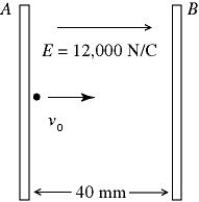Motion of a charged particle: A pair of charged conducting plates produces a uniform field of 12,000 N/C, directed to the right, between the plates. The separation of the plates is 40 mm. An electron is projected from plate A, directly toward plate B, with an initial velocity of vo = 1.0 × 107 m/s, as shown in the figure. (e = 1.60 × 10-19 C, ε0 = 8.85 × 10-12 C2/N ∙ m2, mel = 9.11 × 10-31 kg) The distance of closest approach of the electron to plate B is nearest to 
Definitions:
Item Value
The worth or usefulness of a specific good or service, often determined by factors like utility, demand, and rarity.
Ownership
The legal right or status of having control over something, typically property or goods.
Traditional Economic Theory
A framework that explains economic decisions and behaviors based on the assumption that agents are rational and seek to maximize utility or profit.
Demand Curves
Graphs showing the relationship between the price of a good and the quantity demanded by consumers at those prices.
Q2: Potential due to point-charges: A +4.0 μC-point
Q9: Infinite line of charge: At a distance
Q11: Faraday's law: A closed loop conductor that
Q13: Multiple point-charges: Three +3.0-μC point charges are
Q14: LC circuits: A charged capacitor is connected
Q17: Energy in capacitors: An isolated air-filled parallel-plate
Q26: Gauss's law: Which of the following statements
Q53: Charged ring: In the figure, a ring
Q61: Force on parallel wires: A very long
Q79: Solenoids: A solenoid with 400 turns has